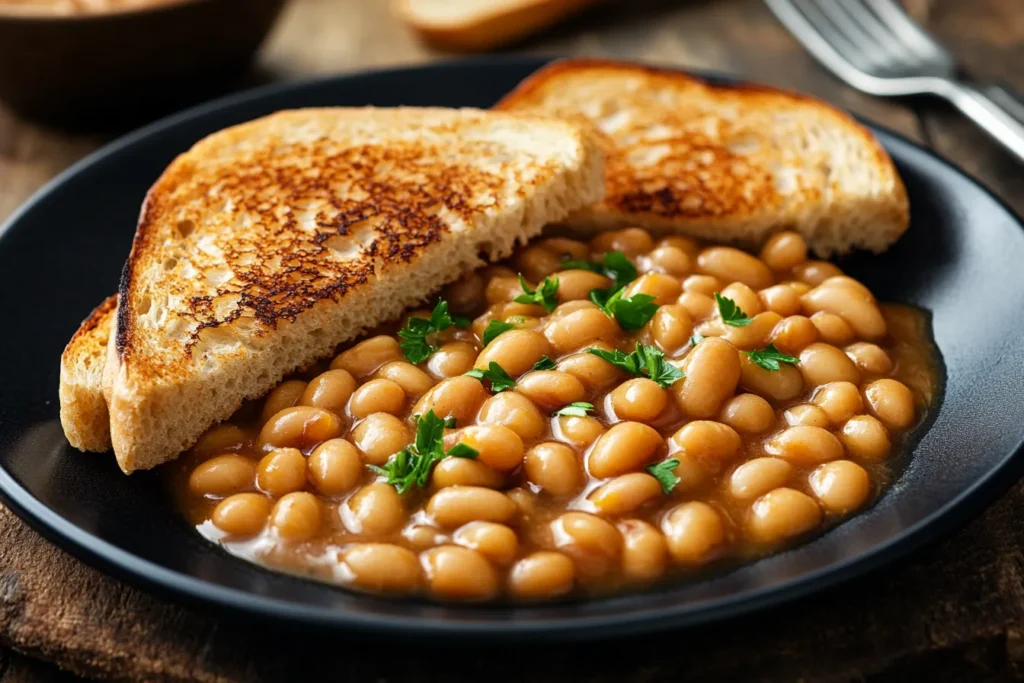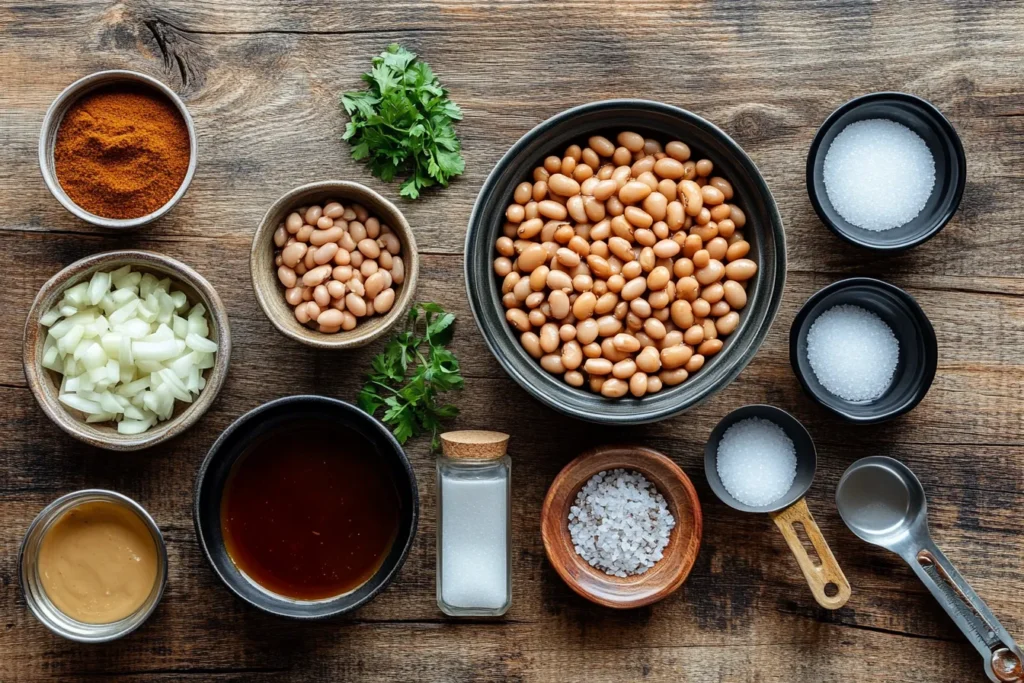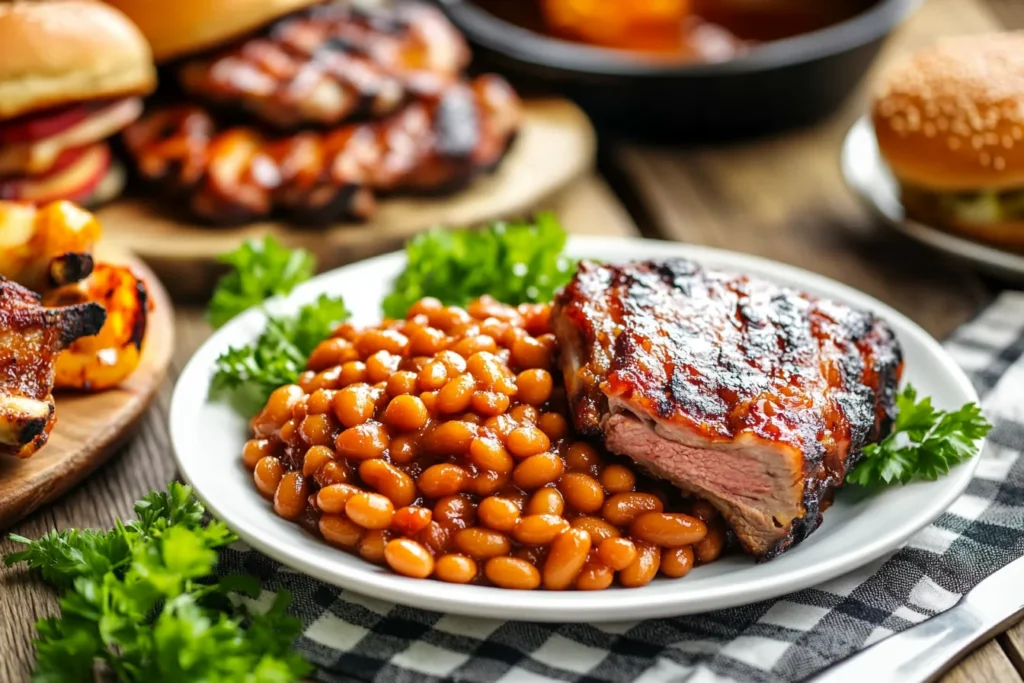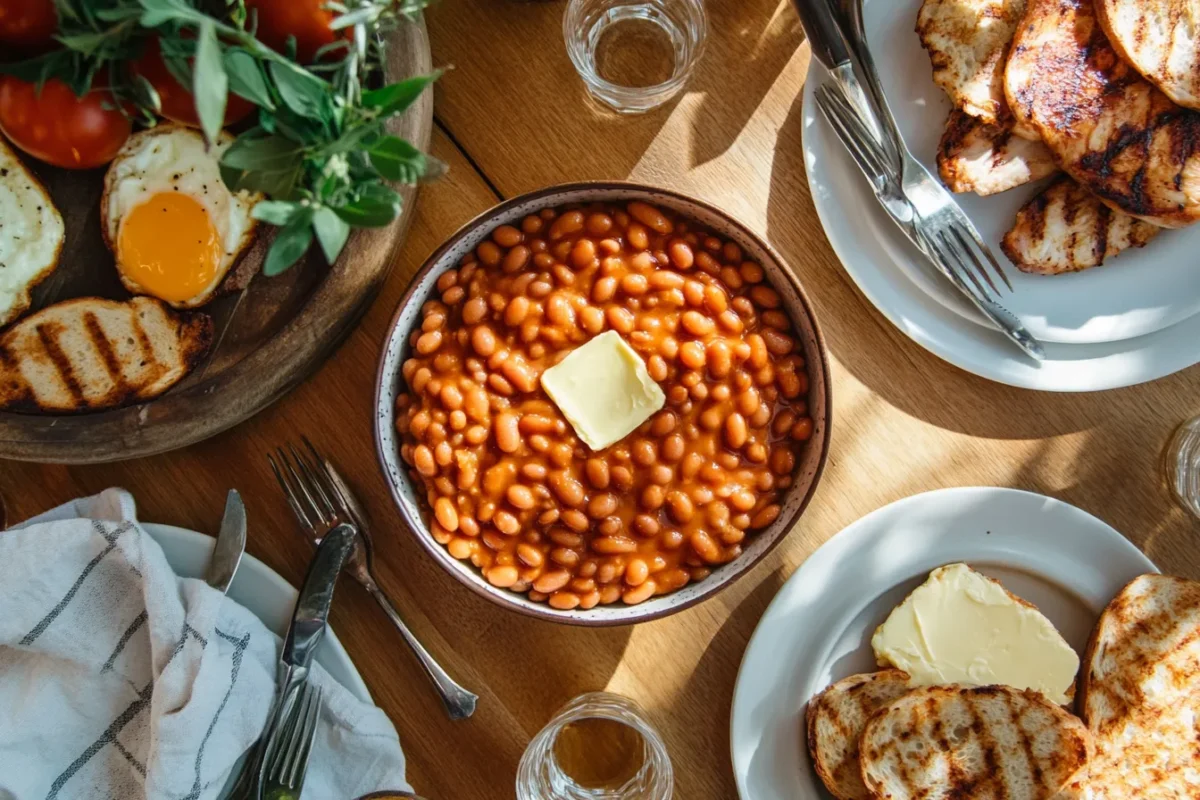Few comfort foods rival the hearty appeal of a baked beans recipe. From breakfast plates to barbecue spreads, this flavorful and nutritious dish is a timeless favorite. In this article, we’ll uncover its rich history, explore tasty variations, and guide you step-by-step to make the perfect homemade baked beans. Let’s get started!
Introduction to the Classic Baked Beans Recipe
Baked beans, made from white beans like navy or great northern, are slow-cooked in a savory-sweet sauce. Their origins trace back to Indigenous American tribes, who cooked beans in clay pots. European settlers later adapted these recipes, adding molasses or syrup, creating the baked beans we enjoy today.
Cultural Significance
More than a side dish, baked beans hold cultural significance worldwide. In the U.S., they’re barbecue staples, while in the UK, they’re a breakfast favorite on toast. Globally, regional variations showcase their versatility and unique flavors.
Nutritional Benefits of a Homemade Baked Beans Recipe
Macronutrients
A baked beans recipe not only offers plant-based protein, but it also makes an ideal choice for vegetarians or anyone seeking a nutritious meal. Furthermore, baked beans are high in fiber, which helps promote digestion and keeps you full longer.
Vitamins and Minerals
This baked beans recipe is a good source of essential vitamins and minerals, such as iron, magnesium, and potassium, which not only boost energy but also support heart health and aid muscle function. In addition to being naturally low in fat, a homemade baked beans recipe is a smart choice for a balanced diet.
The History and Evolution of the Baked Beans Recipe

Baked beans have roots going back centuries with Indigenous American tribes, who originally slowly cooked beans with venison, maple syrup, and bear fat. Later on, European settlers adjusted this method by adding ingredients like molasses in order to create the baked beans we enjoy today.
Evolution Over Time
As trade and cooking styles changed over the years, baked beans also changed. In the late 1800s, canned baked beans became a simple and easy option for many. Today, there are many versions of baked beans, from old family recipes to modern ones made to suit different diets and tastes.
Regional Variations of the Baked Beans Recipe
Boston Baked Beans
Boston baked beans are known for their rich, sweet flavor, which is achieved by slow-cooking beans with molasses and brown sugar. Moreover, this iconic dish reflects New England’s colonial history, when molasses was a common sweetener and played a key role in its caramelized taste.
British Baked Beans
In the UK, baked beans are simmered in a tangy tomato sauce instead of having added sweetness, which sets them apart from American styles. In fact, they are a staple of the full English breakfast, and they’re often served on toast or alongside eggs and hash browns, making for a quick and comforting meal.
Southern-Style Baked Beans
Southern-style baked beans are bold and smoky, typically flavored with barbecue sauce, spices, and smoked turkey or paprika. Moreover, they pair beautifully with grilled meats and are a staple at family gatherings and backyard cookouts.
From the sweet molasses flavors of Boston to the tangy British style and smoky Southern recipes, baked beans demonstrate incredible versatility, adapting to regional preferences while retaining their comforting appeal.
Essential Ingredients for Baked Beans
Types of Beans Used
The foundation of any great baked beans recipe lies in the choice of beans. Navy beans, also known as haricot beans, are the most commonly used due to their creamy texture and ability to absorb flavors. However, other varieties such as great northern beans or pinto beans can be excellent substitutes. The choice of beans can subtly influence the dish’s texture and flavor profile, making it uniquely yours.
Sweeteners (Molasses, Brown Sugar)
Sweeteners are what give baked beans their signature balance of savory and sweet. Traditional recipes often feature molasses, which imparts a deep, robust sweetness with hints of caramel. Brown sugar is another common choice, adding warmth and a touch of molasses flavor without overpowering the dish. These sweeteners not only enhance the taste but also contribute to the beans’ glossy, sticky texture.
Flavor Enhancers (Mustard, Onions)
Flavor enhancers elevate baked beans from simple to sensational. Mustard adds a subtle tangy kick, balancing the sweetness of the dish. Onions, whether caramelized or sautéed, provide a savory depth that complements the sweetness and spices. The combination of these elements ensures every bite is bursting with flavor.
Equipment Needed
Dutch Oven
A Dutch oven is a classic choice for preparing homemade baked beans. Its heavy, cast-iron construction ensures even heat distribution, allowing the beans to cook slowly and evenly. The tight-fitting lid helps retain moisture, creating a rich, thick sauce while the beans soften to perfection.
Slow Cooker
For those who prefer a hands-off approach, a slow cooker is an excellent choice. Not only does this versatile tool allow you to set and forget, but it also lets the beans simmer gently over several hours. As a result, you get a flavorful dish with minimal effort, making it perfect for busy days.
Baking Dish
If you’re baking beans in the oven, a sturdy baking dish is essential. Glass or ceramic dishes work well, as they distribute heat evenly while retaining the beans’ moisture. They’re also great for serving, as they maintain the dish’s warmth during mealtime.
By choosing the right tools and ingredients, you set the stage for baked beans that are flavorful, tender, and irresistibly delicious.
Step-by-Step Baked Beans Recipe
Ingredients List

Beans
- 2 cups dried navy beans
Sauce
- 1/2 cup molasses
- 1/2 cup brown sugar
- 1/4 cup ketchup
- 1 tablespoon Dijon mustard
- 1 teaspoon Worcestershire sauce
- 1/2 teaspoon salt
- 1/4 teaspoon black pepper
Add-ins
- 1 medium onion, finely chopped
- 6 slices of turkey bacon or smoked tofu, diced
Preparation Steps of Baked Beans
Soaking the Beans
Start by rinsing the navy beans under cold water to remove any debris. Next, sort through them carefully, discarding any damaged beans or impurities. To soften the beans and reduce cooking time, soak them in a large bowl of water overnight. If you’re short on time, try the quick-soak method: bring the beans to a boil, then let them sit for an hour before draining.
Preparing the Sauce
In a medium bowl, mix the molasses, brown sugar, ketchup, Dijon mustard, Worcestershire sauce, salt, and black pepper. Whisk everything together until the ingredients are fully combined. The result should be a sweet and tangy sauce with a hint of smokiness that’s perfect for coating the beans.
Cooking the Onions
In a large skillet, heat a small amount of oil over medium heat. Add the diced onions and sauté until they become soft and translucent, which should take about 5 minutes. If desired, you can also include smoked paprika for added flavor. Remove from heat and set aside.
Combining Ingredients
First, drain and rinse the soaked beans to remove any residual starch or bitterness. Next, in a Dutch oven, combine the beans, prepared sauce, and sautéed onions. Then, stir gently to ensure the sauce evenly coats the beans, and that all ingredients are well integrated.
Baking the Beans
Preheat your oven to 300°F (150°C). Cover the Dutch oven with its lid or aluminum foil to retain moisture during cooking. Place it in the oven and bake for 3-4 hours, stirring every hour to prevent sticking and ensure even cooking. The beans are done when they’re tender, and the sauce has thickened to a luscious consistency.
Allow the beans to cool slightly before serving. The end result is a dish that’s bursting with robust flavors, ready to be the star of any meal.
Tips for Perfect Baked Beans
Choosing the Right Beans
The type of bean you use can greatly influence the texture and flavor of your baked beans. Navy beans are the traditional choice, offering a creamy texture and a mild flavor that absorbs seasonings well. If you prefer a firmer bite, consider great northern beans or cannellini beans. When buying dried beans, opt for fresh, high-quality beans, as older ones may take longer to cook and yield inconsistent results.
Adjusting Sweetness and Flavor
Everyone’s palate is different, so don’t hesitate to tweak the sweetness and flavor to your liking. If you prefer sweeter baked beans, add an extra tablespoon of molasses or brown sugar. For those who enjoy a tangier profile, increase the Dijon mustard or Worcestershire sauce. Incorporating smoked paprika or a dash of liquid smoke can enhance the depth of flavor, creating a smokier, richer dish without needing additional ingredients.
Cooking Time and Temperature
Patience is key when making baked beans. Low and slow cooking allows the flavors to meld together beautifully while ensuring the beans become tender without falling apart. Maintain an oven temperature of 300°F (150°C) for best results, and remember to stir occasionally to prevent sticking. If the sauce appears too thick toward the end, add a splash of water or broth to achieve your desired consistency.
Serving Suggestions

Ideal Pairings
Barbecue Dishes
Baked beans are a quintessential side dish for barbecues, complementing grilled chicken, burgers, or ribs with their sweet and smoky flavors. For a satisfying meal, serve your baked beans with this tender and flavorful Instant Pot Corned Beef for a classic combination that’s sure to please.
Toasted Bread
For a simple and satisfying meal, serve baked beans over warm, buttered toast. This combination is a beloved classic, especially in the UK.
Breakfast Plates
Incorporate baked beans into your breakfast spread by pairing them with scrambled eggs, hash browns, and fresh fruit. Their hearty flavor adds depth to any morning meal.
Additional Pairings
For a delicious and healthy pairing, try serving your baked beans alongside this flavorful Chicken Cabbage Stir Fry Recipe, which adds a savory and fresh touch to your meal.
Storing and Reheating Baked Beans
Refrigeration Guidelines
To store leftover baked beans, transfer them to an airtight container and place them in the refrigerator within two hours of cooking. They will stay fresh for up to 5 days. For best results, allow the beans to cool completely before refrigerating to prevent condensation, which can dilute the sauce.
Freezing Instructions
Baked beans freeze exceptionally well! Once cooled, portion them into freezer-safe containers or resealable bags, leaving room for expansion. Label and date the containers, then store them in the freezer for up to 3 months. Thaw overnight in the refrigerator before reheating.
Reheating Methods
To reheat, use a saucepan over low heat, stirring occasionally until the beans are heated through. For a faster option, microwave individual portions in a microwave-safe dish, covering to prevent splatters. Add a splash of water if the sauce has thickened too much during storage.
Proper storage and reheating ensure you can enjoy your homemade baked beans anytime, retaining their delightful flavor and texture.
Dietary Benefits
High Fiber Content
One of the standout nutritional benefits of baked beans is their high fiber content. Fiber aids in digestion, promotes gut health, and helps regulate blood sugar levels. A single serving of baked beans can provide a significant portion of your daily fiber needs, making them an excellent addition to a balanced diet.
Protein Source
For those seeking plant-based protein options, baked beans are a fantastic choice. They contain protein essential for muscle repair, immune function, and overall energy. Whether you’re vegetarian or just trying to include more plant-based meals, baked beans can be a delicious way to meet your protein needs.
Potential Drawbacks
Sugar Content
While the natural sweetness in baked beans is part of their appeal, traditional recipes can be high in sugar due to molasses and brown sugar. For a healthier alternative, consider reducing the amount of sweetener or substituting with natural options like honey or maple syrup in moderation.
Sodium Levels
Canned baked beans and some recipes can contain a significant amount of sodium, which may be concerning for those watching their salt intake. Opt for low-sodium ingredients or seasonings to control the salt content and still enjoy the delicious flavors of homemade baked beans.
Frequently Asked Questions (FAQs)
What can I add to my baked beans?
You can elevate your baked beans by including add-ins like sautéed vegetables, such as bell peppers or celery, smoked paprika, or even a splash of apple cider vinegar for extra tang. Additionally, for a heartier dish, you can mix in diced turkey sausage or alternatively, plant-based protein crumbles.
Which type of beans are used in baked beans?
Navy beans are the most common choice for baked beans due to their soft texture and mild flavor. Alternatives include great northern beans or cannellini beans, which work well as substitutes.
How can I make my beans more flavorful?
The key to flavorful baked beans is a balance of sweet, tangy, and savory elements. Adjust seasonings like mustard, molasses, or spices to suit your taste. Adding sautéed onions and garlic or experimenting with liquid smoke can also enhance the depth of flavor.
Can I use canned beans instead of dried beans?
Absolutely! Canned beans are a convenient substitute for dried beans and reduce prep time. Simply rinse and drain the canned beans before using them in your recipe.
Can I freeze baked beans for later use?
Yes, baked beans freeze well. Once cooled, store them in airtight containers or freezer bags, leaving room for expansion. Thaw in the refrigerator overnight before reheating.
Summarizing the Delight of Homemade Baked Beans
Recap of Key Points
Baked beans are a delightful blend of history, nutrition, and versatility. With simple ingredients like navy beans, molasses, and mustard, you can create a dish that’s not only flavorful but also nourishing. Whether served as a barbecue side dish, on toast, or alongside breakfast favorites, baked beans are a crowd-pleaser in any form.
Encouragement to Try the Recipe
Now that you’ve explored the history, variations, and a step-by-step recipe, it’s time to roll up your sleeves and try making baked beans at home. The rich, savory flavors and the satisfaction of a homemade dish are well worth the effort. Enjoy the process and savor every bite of your perfectly cooked baked beans!

